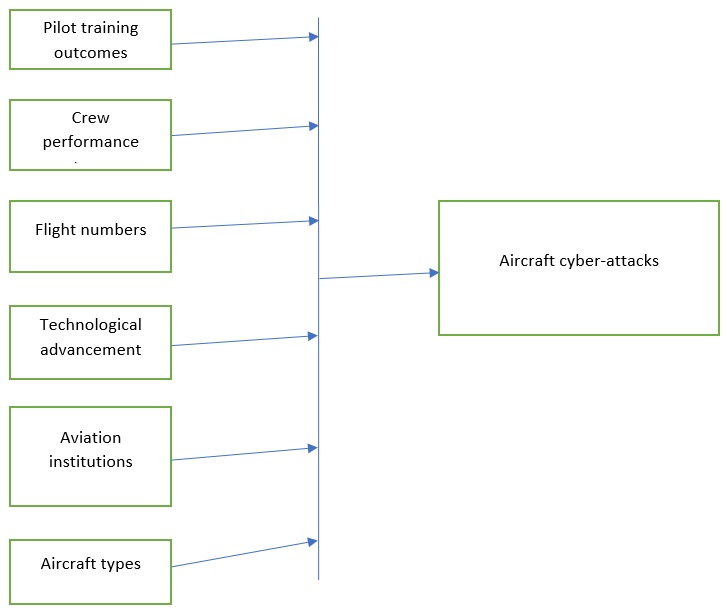A correlational study of the effects of pilot and crew training on combating aircraft cyber-attacks has been presented to describe how each variable affects the other.
Purpose statement
This study aimed to determine the relationship between pilot and crew training and aircraft cyber security attacks. The various factors considered in the study included; pilot training results, crew performance outcomes, the aviation institution, technological advancement, flight numbers, types of aircraft, qualification of pilots, number of crew on board, and the cyber aircraft reports.
Variables
The predictors included:
- Pilot training results.
- Crew performance results.
- Aviation institutions.
- Technological advancement.
- Flight numbers.
- Types of aircrafts.
- Pilot qualifications.
- Number of the crew on board.
Dependent measure
The dependent measure is the number of aircraft cyber-attacks in the aviation industry available from the Federal Aviation Administration (FAA) database.
Operational definitions
The pilot training results involved the performances of individual pilots when the cybersecurity training was conducted in various aviation institutions. These results were recorded, and pilots were graded based on their outcomes. The crew performance outcomes involved the performances of every crew on board and the staff working on different airplanes and aircraft on their preparedness to handle the cyber-attacks on the planes (Patel, 2017). The aviation institutions are accredited learning institutions that offer the training to both the crew and pilots to assess their preparedness to handle the various attacks when they are experienced.
The aviation institutions are further classified as either private or public. The public aviation institutions are controlled and funded by the government and offer training at subsidized charges (Federal Aviation Administration, 2017). Private aviation institutions are those learning centers that have been given the power to operate but under the management of private entities. The technological advancement in this study referred to changes and improvements in technology application which has contributed to an increase in aircraft cyber-attacks. The technological advancement witnessed was primarily from human-induced activities and other natural factors.
The flight numbers represented the various flights operating in the Triple E, Colorado airlines, obtained from the FAA database for the last five years. The aircraft types involved the designs, nature, size, and the purposes of the different aircraft in the aviation industry (Johnson, 2019). Pilot qualifications are the basic requirements that the pilots must have obtained before being licensed to operate the aircraft. The qualification of various pilots was assessed based on their academic, professional, and working experience across multiple airline operations. The aircraft cyber-attacks included the outcome of all the factors and the results from different independent variables.
Research question
What is the relationship between combating the aircraft cyber-attacks in the Triple E, Colorado, and various factors such as pilot training outcomes, crew performance results, flight numbers, technological advancement, and the aviation institutions available?
Statistical hypotheses
- H0: ρ = 0, There is no significant relationship between combating the aircraft cyber-attacks in the Triple E, Colorado, and various factors such as pilot training outcomes, crew performance results, flight numbers, technological advancement, and aviation institutions available.
- H1: ρ ≠ 0, There is a significant relationship between combating the aircraft cyber-attacks in the Triple E, Colorado, and various factors such as pilot training outcomes, crew performance results, flight numbers, technological advancement, and the aviation institutions available

References
Johnson D. P. (2019). Civil aviation and cybersecurity. Honey-well Aerospace Advanced Technology, 56-59. Web.
Federal Aviation Administration. (2017). Aircraft cybersecurity: The pilot’s perspective.Air Line Pilots Association, 1-8.
Patel, R. (2017). Managing cybersecurity risk in weapon systems. Aircraft Systems Authorizing Official, US AIrforce, LCMC, 36-46.